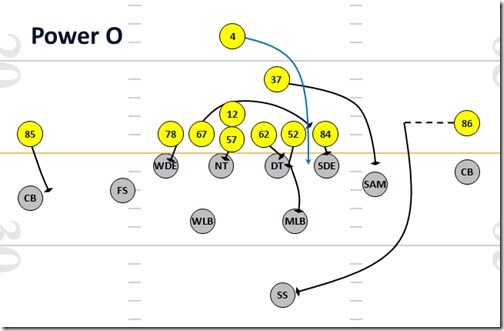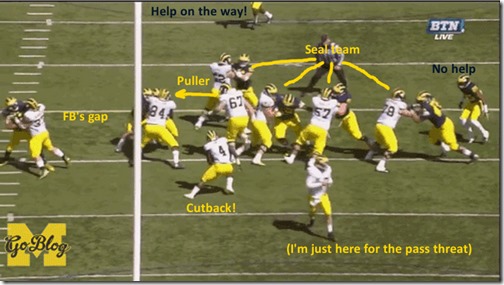Remember that one run that maize Michigan had against blue Michigan? It'll come to you: it was the one when the offense gained yards by running the ball. I mean forward yards, not the sideways stretch things. You know the one on the very first snap of the Spring Game that Ace giffed:

There wasn't much else from the Spring Game to pull out so I thought it would be fun to pick this one apart as a very vanilla example of Harbaugh's Power offense, and Durkin's gap-attacking with speed defense, and where various players are in it.
I also disagree with Brian on what caused this to happen. He gave RJS credit for fighting A.J. Williams to a draw and blamed Desmond Morgan for biting the running back's initial outside cut. Those things happened, but in the context of Durkin's defense I think Jenkins-Stone is mostly at fault for not being aggressive enough. In 4-3 world a tie is a loss.
What the offense was thinking. Here's the design:
This is Power O, the most base play of Harbaughffense, from a base formation for running it. The first play of the game, there was nothing tricky about it—the offense lined up where they snapped except (off camera) Chesson went in motion. You may remember this play from such offenses as Stanford under Harbaugh, and what Borges and Hoke wanted to run with two years of eligibility left on Denard Robinson. Well-defended it ends however far down the field the offense's bodies managed to move the defense's bodies. This wasn't well defended, as we shall see after…
[The Jump]
What the defense was thinking. They aligned in a shell I think of as 4-2-5. There are teams that run a 4-2-5 as their base, using the 4-3's gap-attacking method but applying the 3-3-5's multiple hybrid space players in the slots.
Welcome to D.J. Durkin's World of Weird formations. The line is playing straight-up 4-3 over, except you have #52 Royce Jenkins-Stone as the strongside defensive end. The linebackers are shifted as they would be in the under, putting #12 Alan Gant (the SAM) on a wing in the flat, and walking down the free safety, #25 Dymonte Thomas, as an edge threat to the backside. This is an aggressive-ish defensive formation but fairly ideal for a Cover 1 or a Cover 3—both the SAM and the FS are safety-linebacker hybrids and are playing in their respective flats.
But the offense has no kinds of slot threats here. The Y-tight end is #84 A.J. Williams, and the fullback is #37 Bobby Henderson, a blocking-only walk-on. The defense ought to be able to key a power run and shut it down. Specifically, you would like RJS to use his linebacker speed to attack that C (between the LT and TE) gap and maybe eat the fullback (if it's an ISO) or the pulling guard (if it's Power).
The defense's plan is to have #69 Willie Henry work into the A-gap and hopefully delay the LT in the process, getting a two-for-one and leaving the MLB, #48 Desmond Morgan, to both cover the B-gap, or if the LT and LG don't separate, to be in the hole behind them to help RJS, or if the FB is flaring take an outside lane. Gant is supposed to get upfield and keep the edge.
The WLB, #66 Dan Liesman, immediately reads the guard's pull and will be responsible for neutralizing the advantage the offense gained on that. Let's see how that works.
We're now one beat into the play. The right guard, #67 Kyle Kalis is pulling, and Liesman is going with him. Everyone but RJS is getting into their gaps—NT #96 Ryan Glasgow can't work to playside just yet, but soon enough Thomas will show to the backside and Glasgow will try to flow. This is long enough for the center, #57 Patrick Kugler, to seal him.
Morgan is already spotting a potential situation though. He's supposed to have the "B" gap that's between the LT #52 Mason Cole and LT #62 Blake Bars right then, but he's also seeing the fullback's flare toward the SAM; there's going to be an extra lane outside. He can't shoot up into Cole either because if it's play-action he's dead.
He also sees RJS has gotten no better than a stalemate with Williams. In the thinking of 3-4 this is fine—a DE controlling a blocker allows the LB to flow to either gap. In 4-3 thinking this isn't so good, since RJS is responsible for the "C" gap, Morgan has the "B" gap, and they should both be attacking those to penetrate upfield so the ball can't get to the outside (where it's fullback and running back vs. Gant).
With Jenkins-Stone basically two-gapping instead of 4-3 attacking, Morgan will start to play a little 3-4 style linebacker here, and that's the beginning of bad things for the defense.
Key Blocks
One beat later the offense has used up the initiative and soon will be committed to a single gap. The running back is already moving his feet before the handoff in anticipation of where he'll attack. This is when good RB decisions are made.
Meanwhile this frame does a great job of showing how every incremental difference in the execution of the OL's blocks versus the execution of the gap-attacking DL can make or break a play. See R.Glasgow trying to burrow up into Kugler? A great NT, or a good one against a light center, can blow up the pull—getting a two-for-one—by squeezing down the space the puller has to get by. If Kugler's pushed half a yard further back, his legs are in Kalis's way, and the pull has to widen, therefore arriving later to the hole with less momentum.
Here he has just enough space and agility to get by. Once Kugler's won that mini-battle, he will be fighting to keep Glasgow from flowing down the line, and he's getting in good position to do so. The fullback is still stalking the SAM, hoping to create a gap out there. Williams is still fighting RJS from getting to his gap.
Cole is lurching a bit, having won the battle too easily with Henry (who was always going for the A-gap). This is a good time to have great balance for an OL, because the sooner Cole is back on his feet the sooner he can start picking off second level defenders. If you recall, one of the complaints last year was Braden would often find himself leaning too far forward and would fall down rather than make a block once the defender he moved has moved on. Mason Cole is the opposite: he's athletic enough with those freakish hips and tush to swing his right leg way out without his shoulders coming unsquared from his next blocking target. He's already eyeing Liesman, the WLB dutifully following the pulling guard. I'd imagine he'd have a harder time with Bolden or Ross shooting into the gap, but this is still boss. Mason Cole is boss.
Lastly, see what Smith is thinking. Shooting into that hole could get you three or four fall-forward yards, maybe more if the linebacker's the type you can run over. But that wastes the puller, and the linebacker could just stuff him. If Smith has matured in this offense he'll know that MLB has to worry about the outside and can get tricksome.
In half a beat it looks like this:
Cole is good—he's off his block and widening and big enough that the WLB's best shot won't push the hole any thinner. The FB is also creating space, enough space in fact that Smith's cut to the outside, immediately read by the MLB who's watching the handoff so he can react, is going to draw Morgan to a "D" gap that wasn't there before.
Trapped
And now the bad thing that was going to happen to the defense occurs: Morgan sets up behind Willliams to play the gap it seems Smith was going for, but Smith is good and one step later he's back to accelerating into the "C" gap.
This remember is supposed to be RJS's gap, but RJS is still tied up with A.J. Williams, and while having that occur a tiny bit in the backfield was a good thing for squeezing these gaps, if Bolden is going to the "D" gap Jenkins-Stone really needs to control the other side of Williams right now. Because the RB is cutting in there, and the puller is arriving there. Can RJS get back on the right side of his block before…
Nope. In fact Williams gets a win by controlling that inside shoulder so RJS can't even dive for the ballcarrier. We can only fault him so much; he was a linebacker a few months ago and is head-to-head on a 300-pound tight end.
The Result
Anyway Kalis decides to use his block to answer the Morgan question for good. Smith is crossing the line of scrimmage and will get 6 to 8 yards depending on what happens with that filling safety (Wilson). Except someone else has now come into our picture.
It's #86 Jehu Chesson! The Z receiver, he has arrived from all the way from the numbers to harass Wilson's tackle attempt! How did he get so free? Who on the defense was supposed to be there? Where's…
…Countess, who backed off when Chesson went in motion, then attacked the gap Morgan had taken when Blake thought Chesson would be cracking the SAM. In the other (first) angle in the video you can see Chesson first went like he was going to crack the SAM inside, though that was the fullback's block. If that happens Countess has to control the resulting outside gap and force back to help. So Countess comes up, Chesson moves on, and now the defense has lost its edge too. Twenty-five more yards ensue.
Video
About the motion
By having the Z receiver (Chesson) come in like the maize team got itself an extra blocker, and occupied Gant a little longer since the receiver would be starting a pass route into the slot. That little movement can set up a bunch of counters to this base play, for example a Z drag route with a boot roll, or have both Chesson and Williams go vertical to stretch the SAM's zone. It also sets up a reverse.
…or a bubble screen, or the good ol' fashioned Transcontinental play that Lloyd brought back this weekend, plus the other trick play.
Lessons
This isn't about Harbaugh doing anything scheme-wise except the defense was not cheating to the playside despite all the power there, a sign that it respects the likelihood of an attack on the backside.
The big things that made this play:
- Cole's two very good blocks,
- RJS is a linebacker trying to do 5-tech things, and the play went right at his hole.
- Morgan had a chance to play hero but got caught outside because DeVeon Smith decided before the handoff he was going to sell the "D" gap then go inside.
- Countess attacked the same gap as Morgan, getting out of position too late to close down or negate Chesson as a blocker
Also Kalis had a decent pull that took some agility to get around Kugler. The first thing above is encouraging and the Smith move was as well, but I think mostly this play was Hargbaugh's most vanilla play run over a soft point in the defense. This was not exploited again as the defense got more aggressive at attacking their gaps.
Distilled into Coachspeak
We'd like the frontside end (Jenkins-Stone) to get more aggressive.









